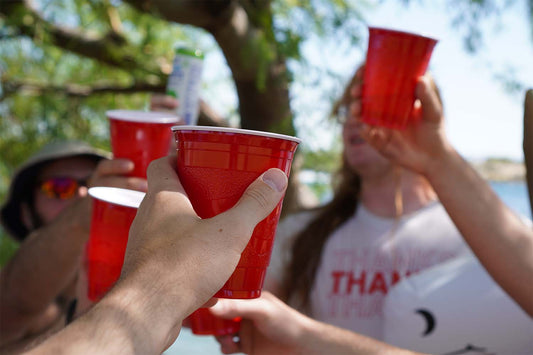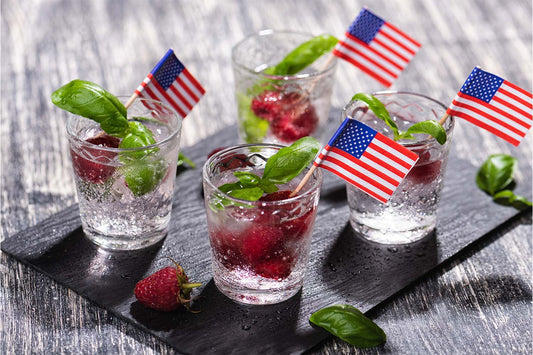There are five cardinal spirits that you’ll find in most cocktails — and on the shelves of every bar the world over. These spirits are vodka, gin, tequila, whiskey, and rum. For a lot of us, this is where our knowledge of spirits ends.
Did you know there are dozens of different spirits throughout the world? Each of these lesser-known varieties is unique, offering its own flavor profile, production style, and history. Perhaps the most popular spirit outside of those five cardinal spirits is brandy, but some of us better know brandy as grappa.
Are grappa and brandy really the same thing? While they may have many similarities, these two delicious liquors are not interchangeable. Here are the main differences between grappa and grape brandy and how you can use them both to create delicious cocktails.
What Is Grape Brandy?
Before we can jump into the differences between grape brandy and grappa, we need to start with an overview of what they are.
Grape brandy is a distilled spirit made from fermented grapes.
Brandy can be made from many fruits, including apples, pears, peaches, and many others, but grape brandy is by far the most common type of brandy. While the process of making brandy follows similar steps across the globe, there are no legal requirements dictating brandy production.
Brandy generally tastes fruity, bright, and subtly sweet with some of the same dark, oaky flavors that you would find in a whiskey. This is due to the similar aging processes for brandy and whiskey.
That said, brandy is usually a lighter, mellower, and fruitier spirit than whiskey, despite its typical 40% or higher ABV.
What Is Grappa?
Many people believe that grappa is a type of brandy. Depending on who you ask, they might be correct since the rules and regulations surrounding brandy are so loose. Grappa is an Italian-made spirit that is technically a pomace brandy (sometimes).
Grappa is made by distilling only the solid parts of the grape — the skin and seeds — as opposed to the whole grape you’d find in most brandies. These solids, called the pomace, are the leftover portions of the grape not used for winemaking.
The use of the pomace creates a distinct flavor for grappa, which is unique from most brandies. Grappa typically has a more sour flavor than grape brandy, as well as a honey sweetness. Like grape brandy, grappa is a high ABV spirit, clocking in at 40% or more ABV.
What Are the Differences Between Grape Brandy and Grappa?
You might be thinking these two beverages sound pretty darn alike — so what’s the difference? Now that we have a brief overview of both grape brandies and grappa, we’re ready to dive into the specific differences between the two.
Brandy and Grappa: Location
Brandy can be made anywhere in the world, although different localities may have their own regulations about what can and cannot be labeled as brandy. Brandy is one of the oldest distilled spirits in the world, and variations of brandy can be found globally.
Grappa, on the other hand, must be made in Italy. Not only must the grappa be made in Italy, but its grapes need to be made in Italy, too.
Brandy and Grappa: Ingredients
Grappa and brandy use similar but not interchangeable ingredients. Brandy is traditionally made using wine, distilling it to make brandy. This can also be done with the fruits of many other juices, which is why there are pear, apple, cherry, and other brandy variations.
Grappa can only be made with grapes. Plus, it’s not made with the liquid from the grapes, only fermenting the solids — AKA the skins, seeds, and sometimes even stems, called the pomace.
This pomace is much more delicate during the fermentation process, so grappa distillers have to have impeccable taste to create a delicious grappa. While brandy production still takes skill, grappa requires a distinct type of finesse.
Brandy and Grappa: Aging
The aging process is probably the most significant difference between these two spirits since brandy does not have to be aged.
Different designations of brandy, like Cognac, do have more specific rules on aging. But any brandy that you purchase simply labeled as brandy has no required aging specification. These bottles can be unaged or several decades old.
Grappa does not have a required minimum, but there are specific names for grappa ages. The youngest grappas are called “Giovanni” (that’s Italian for young), and they’re bottled after a very short rest in stainless steel tanks.
The next level of grappa — “Affinata,” AKA “refined” — is aged for a minimum of one year in wood. Anything 12 to 18 months gets the title “Invecchiata,” meaning aged.
Finally, “Stravecchia” or “Riserva” status are grappas aged for more than eighteen months in wood.
Brandy and Grappa: Taste
Brandy and grappa taste different, too. Specifically, there is much more variation in the flavor of brandies than in grappas. Grape brandy can be aged, unaged, made from all sorts of different grapes and wines, and can come from anywhere in the world.
Grappa, however, must be made from the pomace of Italian grapes, so there is a little less taste variation. In general, grappa is sweet, fruity, and floral in taste and aroma with a unique honey sweetness.
The more aged the grappa, the more woody, caramel, vanilla, and oaky its flavors are. Younger grappas are more fruity and light, giving you a range of options and cocktail applications.
Grappa and Brandy Alternatives
Brandies are sold everywhere, but grappa can be a lot more difficult to locate outside of Italy, Europe, and the Mediterranean. Lucky for us, there are plenty of great grappa alternatives.
Many of our Haus apéritifs can give you a grappa-like experience. Haus apéritifs are also made with fermented grapes alongside other ingredients that produce a delightful drinking experience. If you want to experience the bright, floral, and fruity elements of Giovanni grappa, reach for a Haus Citrus Flower apéritif.
If you want to try the darker, more aged, and intense caramel flavors that come with a Riserva, a Haus New Fashioned apéritif might be right up your alley. New Fashioned features the sweetness and dark spice flavors like cinnamon and ginger that come with dark spirits.
Give these or any of our other flavors a try, and see the kind of flavor experience that grape-based distilled drinks have to offer the world of alcohol.
Grappa vs. Grape Brandy: What’s the Difference?
Grappa and grape brandy are similar but distinct. While all grappas can be a type of brandy, not all brandies are grappas. That’s because of the specific rules and regulations that go into making a delicious Italian grappa.
The main distinction between the two is that while grape brandy is a distilled beverage from wine, grappa is made with the leftover ingredients of winemaking: the skins, seeds, and stems of the grapes. This gives grappa a much earthier, more delicate, and harder-to-perfect flavor.
Finding grappa in the United States is not an easy task — unless you have a local Italian liquor store nearby. Thankfully, we offer several grappa alternatives here at Haus that can give you a similar experience to grappa whenever it suits your fancy.
Give it a try, and check out our collection of delicious and light flavors.
Sources
What Is Brandy? | The Spruce Eats
The 6 Essentials of Grappa - What You Need to Know | Thirsty Mag
The History Of Grappa | Origins & Best Bottles | Life In Italy




